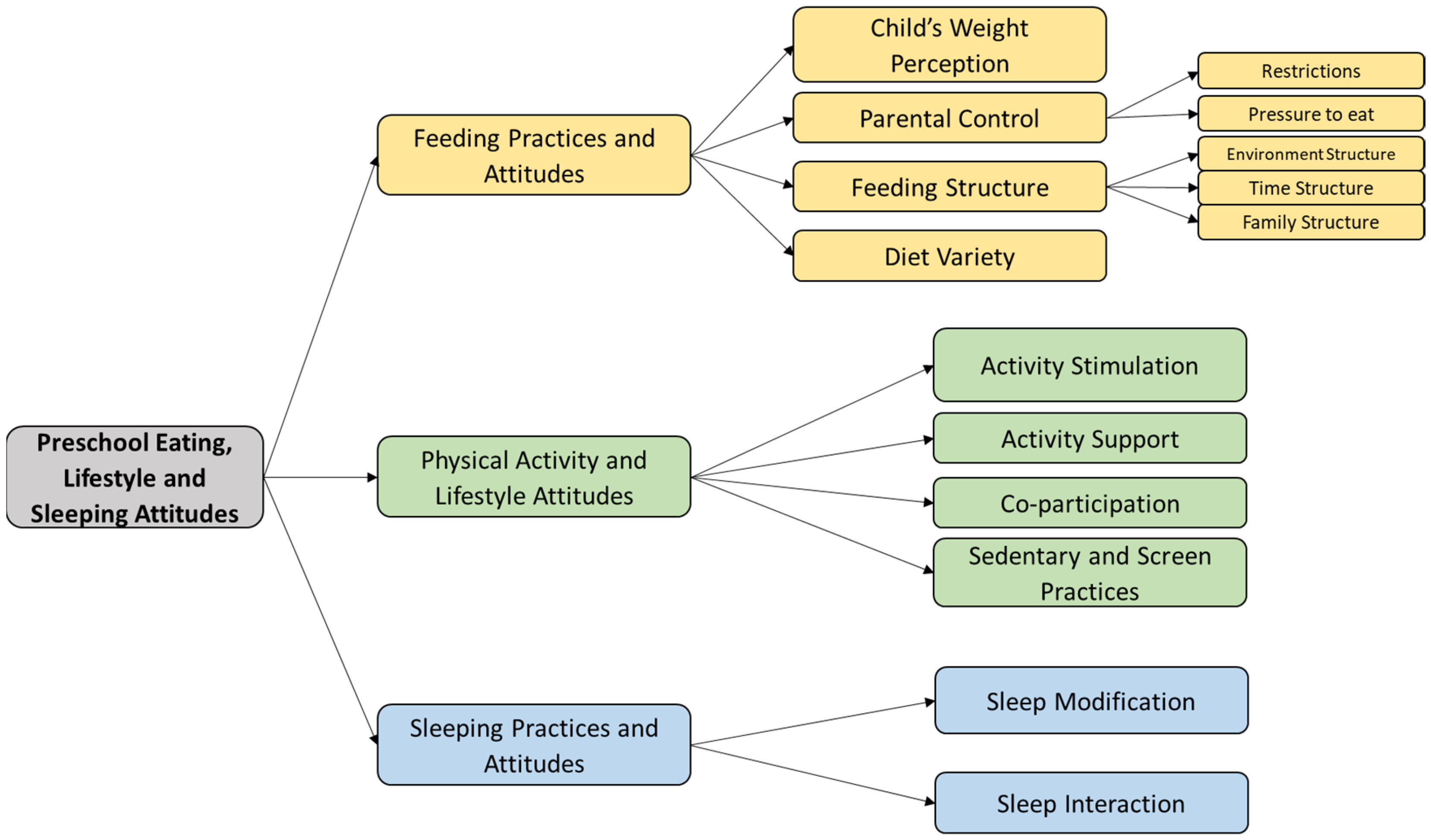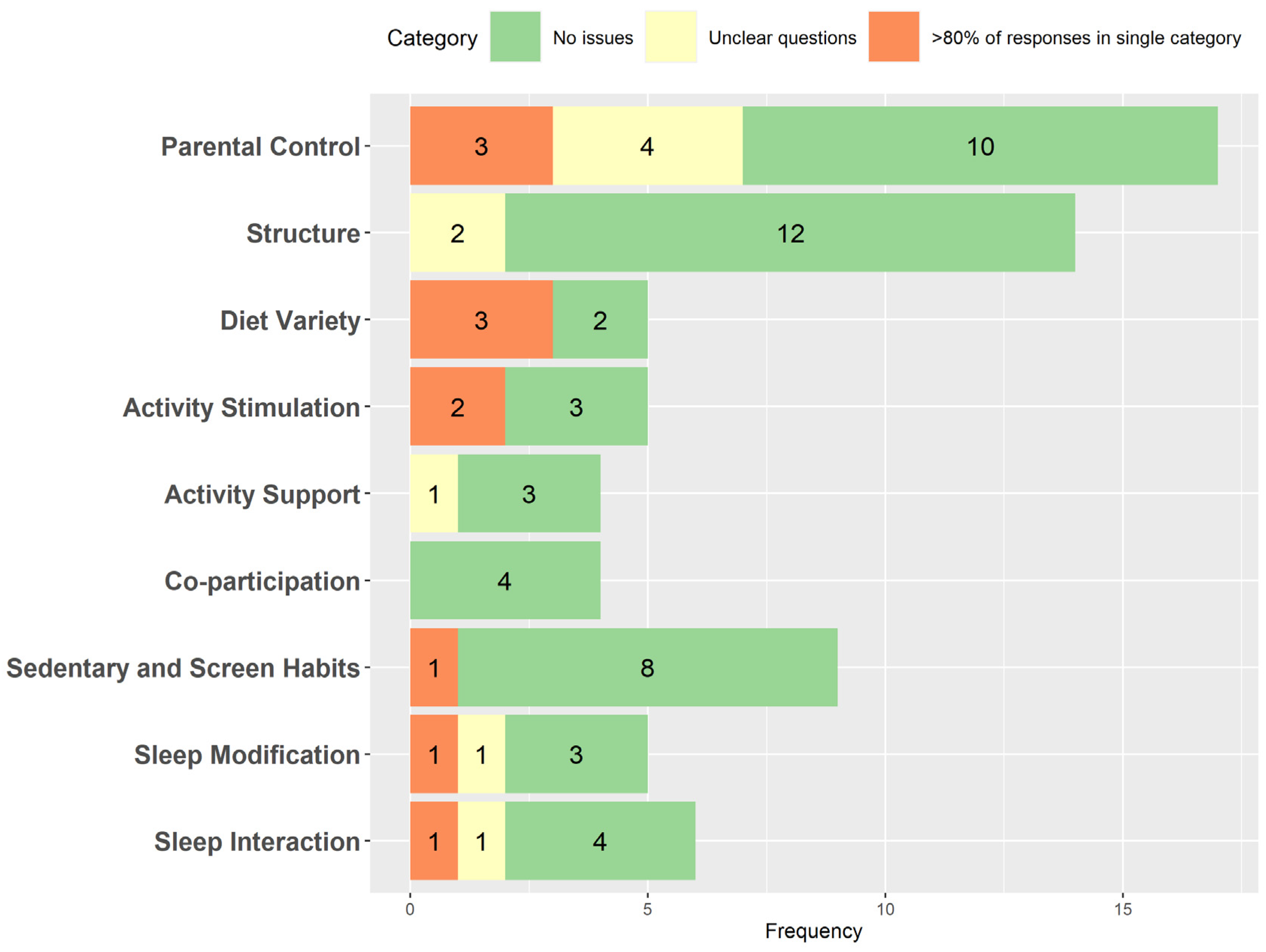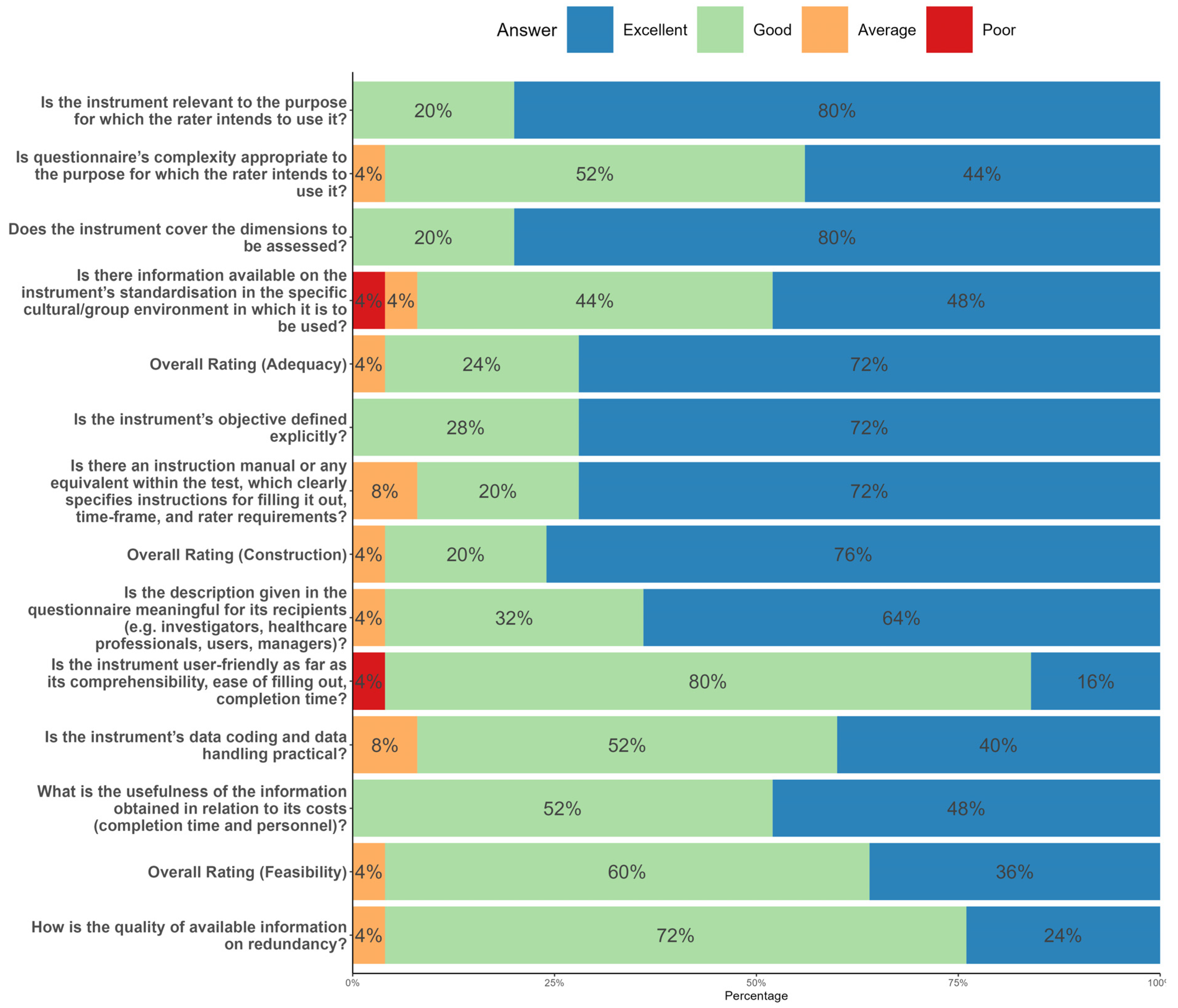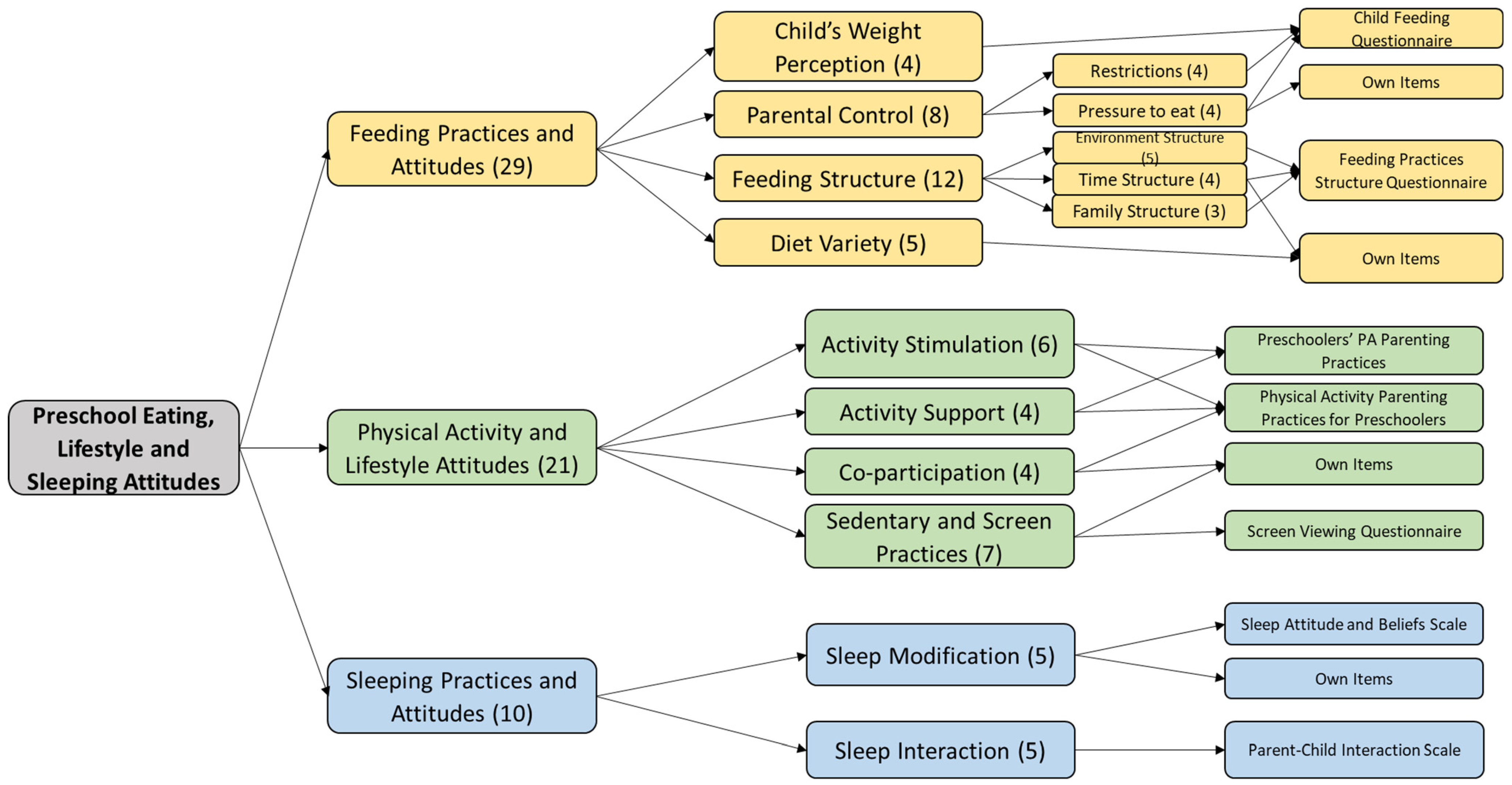The Preschool Eating, Lifestyle, and Sleeping Attitudes Scale (PRELSA Scale): Construction and Pilot Testing of a Tool to Measure Factors Associated with Childhood Obesity
Abstract
1. Introduction
2. Materials and Methods
2.1. Phase 1: Design and Creation of the Scale
2.1.1. Feeding Practices and Attitudes
2.1.2. Physical Activity and Lifestyle Attitudes
2.1.3. Sleeping Practices and Attitudes
2.1.4. Sociodemographic Characteristics and Habit and Behavioral Variables
2.2. Phase 2: Pilot Test
2.3. Data Analysis
3. Results
3.1. Pilot Test, Families Phase
3.2. Pilot Test, Experts Phase
4. Discussion
Strengths and Limitations
5. Conclusions and Future Work
Supplementary Materials
Author Contributions
Funding
Institutional Review Board Statement
Informed Consent Statement
Data Availability Statement
Acknowledgments
Conflicts of Interest
References
- World Health Organization Obesity and Overweight. Available online: https://www.who.int/news-room/fact-sheets/detail/obesity-and-overweight (accessed on 7 February 2023).
- World Health Organization. WHO European Regional Obesity Report 2022; Regional Office for Europe; World Health Organization: Geneva, Switzerland, 2022. [Google Scholar]
- World Obesity Federation. Global Atlas on Childhood Obesity; World Obesity Federation: London, UK, 2019. [Google Scholar]
- Kachur, S.; Lavie, C.J.; De Schutter, A.; Milani, R.V.; Ventura, H.O. Obesity and Cardiovascular Diseases. Minerva Med. 2017, 108, 212–228. [Google Scholar] [CrossRef] [PubMed]
- Garg, S.K.; Maurer, H.; Reed, K.; Selagamsetty, R. Diabetes and Cancer: Two Diseases with Obesity as a Common Risk Factor. Diabetes Obes. Metab. 2014, 16, 97–110. [Google Scholar] [CrossRef] [PubMed]
- Ministerio de Sanidad, Consumo y Bienestar Social—Portal Estadístico Del SNS—Encuesta Europea de Salud En España 2014. Available online: https://www.mscbs.gob.es/estadEstudios/estadisticas/EncuestaEuropea/Enc_Eur_Salud_en_Esp_2014.htm (accessed on 3 February 2020).
- AESAN. Estudio Aladino 2019—Estudio de Vigilancia del Crecimiento, Alimentación, Actividad Física, Desarrollo Infantil y Obesidad en España.; AESAN: Vigo, Spain, 2019. [Google Scholar]
- Simmonds, M.; Burch, J.; Llewellyn, A.; Griffiths, C.; Yang, H.; Owen, C.; Duffy, S.; Woolacott, N. The Use of Measures of Obesity in Childhood for Predicting Obesity and the Development of Obesity-Related Diseases in Adulthood: A Systematic Review and Meta-Analysis. Health Technol. Assess. 2015, 19, 1–336. [Google Scholar] [CrossRef] [PubMed]
- Rolland-Cachera, M.F.; Deheeger, M.; Maillot, M.; Bellisle, F. Early Adiposity Rebound: Causes and Consequences for Obesity in Children and Adults. Int. J. Obes. 2006, 30, S11–S17. [Google Scholar] [CrossRef]
- Díaz-Rodríguez, M.; Pérez-Muñoz, C.; Lendínez-De la Cruz, J.M.; Fernández-Gutiérrez, M.; Bas-Sarmiento, P.; Ferriz-Mas, B.C. Effectiveness of a Multifactorial Intervention in the First 1000 Days of Life to Prevent Obesity and Overweight in Childhood: Study Protocol. Int. J. Environ. Res. Public. Health 2020, 17, 2239. [Google Scholar] [CrossRef]
- Robinson, S.M.; Crozier, S.R.; Harvey, N.C.; Barton, B.D.; Law, C.M.; Godfrey, K.M.; Cooper, C.; Inskip, H.M. Modifiable Early-Life Risk Factors for Childhood Adiposity and Overweight: An Analysis of Their Combined Impact and Potential for Prevention. Am. J. Clin. Nutr. 2015, 101, 368–375. [Google Scholar] [CrossRef]
- Hammons, A.J.; Fiese, B.H. Is Frequency of Shared Family Meals Related to the Nutritional Health of Children and Adolescents? Pediatrics 2011, 127, e1565–e1574. [Google Scholar] [CrossRef]
- He, B.; Long, W.; Li, X.; Yang, W.; Chen, Y.; Zhu, Y. Sugar-Sweetened Beverages Consumption Positively Associated with the Risks of Obesity and Hypertriglyceridemia among Children Aged 7–18 Years in South China. J. Atheroscler. Thromb. 2018, 25, 81–89. [Google Scholar] [CrossRef]
- He, M.; Piché, L.; Beynon, C.; Harris, S. Screen-Related Sedentary Behaviors: Children’s and Parents’ Attitudes, Motivations, and Practices. J. Nutr. Educ. Behav. 2010, 42, 17–25. [Google Scholar] [CrossRef]
- Berghtein, I.R. Obesity and Sedentary Lifestyles in Four-Years Old Children Attending Two Pre-Schools in the City of Rio Grande, Tierra Del Fuego, Argentina. Arch. Argent. Pediatr. 2014, 112, 557–561. [Google Scholar] [CrossRef]
- Bagherniya, M.; Darani, F.M.; Sharma, M.; Maracy, M.R.; Birgani, R.A.; Ranjbar, G.; Taghipour, A.; Safarian, M.; Keshavarz, S.A. Assessment of the Efficacy of Physical Activity Level and Lifestyle Behavior Interventions Applying Social Cognitive Theory for Overweight and Obese Girl Adolescents. J. Res. Health Sci. 2018, 18, e00409. [Google Scholar]
- Dos Santos El Halal, C.; Nunes, M.L. Sleep and Weight-Height Development. J. Pediatr. 2019, 95, 2–9. [Google Scholar] [CrossRef]
- Reilly, J.J.; Armstrong, J.; Dorosty, A.R.; Emmett, P.M.; Ness, A.; Rogers, I.; Steer, C.; Sherriff, A. Early Life Risk Factors for Obesity in Childhood: Cohort Study. Br. Med. J. 2005, 330, 1357–1359. [Google Scholar] [CrossRef]
- Junta de Andalucía Programa de Salud Infantil y Adolescente de Andalucía. Available online: http://www.juntadeandalucia.es/educacion/portals/delegate/content/e84541cc-306c-4f01-8d68-19aadc05fc57 (accessed on 5 February 2020).
- Dalmau, J.; Peña-Quintana, L.; Moráis, A.; Martínez, V.; Varea, V.; Martínez, M.J.; Soler, B. Análisis Cuantitativo de La Ingesta de Nutrientes En Niños Menores de 3 Años. Estudio ALSALMA. An. Pediatr. Engl. Ed. 2015, 82, 255–266. [Google Scholar] [CrossRef]
- Madrigal, C.; Soto-méndez, M.J.; Hernández-ruiz, Á.; Ruiz, E.; Valero, T.; Ávila, J.M.; Lara-villoslada, F.; Leis, R.; de Victoria, E.M.; Moreno, J.M.; et al. Dietary and Lifestyle Patterns in the Spanish Pediatric Population (One to <10 Years Old): Design, Protocol, and Methodology of the EsNuPI Study. Nutrients 2019, 11, 3050. [Google Scholar] [CrossRef]
- Rhodes, R.E.; Guerrero, M.D.; Vanderloo, L.M.; Barbeau, K.; Barbeau, K.; Birken, C.S.; Chaput, J.P.; Faulkner, G.; Janssen, I.; Madigan, S.; et al. Development of a Consensus Statement on the Role of the Family in the Physical Activity, Sedentary, and Sleep Behaviours of Children and Youth. Int. J. Behav. Nutr. Phys. Act. 2020, 17, 1–31. [Google Scholar] [CrossRef]
- Skouteris, H.; Mccabe, M.; Swinburn, B.; Newgreen, V.; Sacher, P.; Chadwick, P. Parental Influence and Obesity Prevention in Pre-Schoolers: A Systematic Review of Interventions. Obes. Rev. 2011, 12, 315–328. [Google Scholar] [CrossRef]
- Romanos-Nanclares, A.; Zazpe, I.; Santiago, S.; Marín, L.; Rico-Campà, A.; Martín-Calvo, N. Influence of Parental Healthy-Eating Attitudes and Nutritional Knowledge on Nutritional Adequacy and Diet Quality among Preschoolers: The SENDO Project. Nutrients 2018, 10, 1875. [Google Scholar] [CrossRef]
- Delisle Nyström, C.; Abbott, G.; Cameron, A.J.; Campbell, K.J.; Löf, M.; Salmon, J.; Hesketh, K.D. Maternal Knowledge Explains Screen Time Differences 2 and 3.5 Years Post-Intervention in INFANT. Eur. J. Pediatr. 2021, 180, 3391–3398. [Google Scholar] [CrossRef]
- Hesketh, K.D.; Kuswara, K.; Abbott, G.; Salmon, J.; Hnatiuk, J.A.; Campbell, K.J. How to Change Young Children’s Physical Activity and Sedentary Behavior: Mechanisms of Behavior Change in the INFANT Cluster Randomized Controlled Trial. Children 2021, 8, 470. [Google Scholar] [CrossRef]
- Ling, J.; Robbins, L.B.; Wen, F.; Zhang, N. Lifestyle Interventions in Preschool Children: A Meta-Analysis of Effectiveness. Am. J. Prev. Med. 2017, 53, 102–112. [Google Scholar] [CrossRef] [PubMed]
- Garcia-Conde, M.G.; Marin, L.; de Maya, S.R.; Cuestas, P.J. Parental Attitudes to Childhood Overweight: The Multiple Paths through Healthy Eating, Screen Use, and Sleeping Time. Int. J. Environ. Res. Public. Health 2020, 17, 7885. [Google Scholar] [CrossRef] [PubMed]
- De Vet, H.; Terwee, C.; Mokkink, L.; Knol, D. Measurement in Medicine, 1st ed.; Cambridge University Press: Cambdridge, MA, USA, 2011; ISBN 978-0-521-11820-0. [Google Scholar]
- Vaughn, A.E.; Ward, D.S.; Fisher, J.O.; Faith, M.S.; Hughes, S.O.; Kremers, S.P.J.; Musher-eizenman, D.R.; Connor, T.M.O.; Patrick, H.; Power, T.G. Fundamental Constructs in Food Parenting Practices: A Content Map to Guide Future Research. Nutr. Rev. 2016, 74, 98–117. [Google Scholar] [CrossRef] [PubMed]
- Canals-Sans, J.; Blanco-Gómez, A.; Luque, V.; Ferré, N.; Ferrando, P.J.; Gispert-Llauradó, M.; Escribano, J.; Closa-Monasterolo, R. Validation of the Child Feeding Questionnaire in Spanish Parents of Schoolchildren. J. Nutr. Educ. Behav. 2016, 48, 383–391.e1. [Google Scholar] [CrossRef]
- Birch, L.L.; Fisher, J.O.; Grimm-thomas, K.; Markey, C.N.; Sawyer, R.; Johnson, S.L. Confirmatory Factor Analysis of the Child Feeding Questionnaire: A Measure of Parental Attitudes, Beliefs and Practices about Child Feeding and Obesity Proneness. Appetite 2001, 36, 201–210. [Google Scholar] [CrossRef]
- Musher-Eizenman, D.; Holub, S. Comprehensive Feeding Practices Questionnaire: Validation of a New Measure of Parental Feeding Practices. J. Pediatr. Psychol. 2007, 32, 960–972. [Google Scholar] [CrossRef]
- Jansen, E.; Mallan, K.M.; Nicholson, J.M.; Daniels, L.A. The Feeding Practices and Structure Questionnaire: Construction and Initial Validation in a Sample of Australian First-Time Mothers and Their 2-Year Olds. Int. J. Behav. Nutr. Phys. Act. 2014, 11, 72. [Google Scholar] [CrossRef]
- García-Blanco, L.; Berasaluce, A.; Romanos-Nanclares, A.; Martínez-González, M.Á.; Moreno-Galarraga, L.; Martín-Calvo, N. Parental Perception of Child’s Weight, Their Attitudes towards Child’s Dietary Habits and the Risk of Obesity. World J. Pediatr. 2022, 18, 482–489. [Google Scholar] [CrossRef]
- Rhodes, R.E.; Perdew, M.; Malli, S. Correlates of Parental Support of Child and Youth Physical Activity: A Systematic Review. Int. J. Behav. Med. 2020, 27, 636–646. [Google Scholar] [CrossRef]
- Larios, S.E.; Ayala, G.X.; Arredondo, E.M.; Baquero, B.; Elder, J.P. Development and Validation of a Scale to Measure Latino Parenting Strategies Related to Children’s Obesigenic Behaviors. The Parenting Strategies for Eating and Activity Scale (PEAS). Appetite 2009, 52, 166–172. [Google Scholar] [CrossRef]
- Sinan, O.; Kucuk, S.; Tosun, B.; Uludasdemir, D.; Kucuk, M. Parenting Strategies for Eating and Activity Scale (Peas): Turkish Validity and Reliability Study. Prog. Nutr. 2019, 21, 413–420. [Google Scholar] [CrossRef]
- Soto, S.C.; Arredondo, E.M.; Horton, L.A.; Ayala, G.X. Validation of the Modified Parenting Strategies for Eating and Physical Activity Scale-Diet (PEAS-Diet) in Latino Children. Appetite 2016, 98, 55–62. [Google Scholar] [CrossRef]
- O’Connor, T.M.; Cerin, E.; Hughes, S.O.; Robles, J.; Thompson, D.I.; Mendoza, J.A.; Baranowski, T.; Lee, R.E. Psychometrics of the Preschooler Physical Activity Parenting Practices Instrument among a Latino Sample. Int. J. Behav. Nutr. Phys. Act. 2014, 11, 3. [Google Scholar] [CrossRef]
- Suen, Y.N.; Cerin, E.; Barnett, A.; Huang, W.Y.J.; Mellecker, R.R. Development of Physical Activity-Related Parenting Practices Scales for Urban Chinese Parents of Preschoolers: Confirmatory Factor Analysis and Reliability. J. Phys. Act. Health 2017, 14, 692–700. [Google Scholar] [CrossRef]
- Cheng, C.; Martin-Biggers, J.; Quick, V.; Spaccarotella, K.; Byrd-Bredbenner, C. Validity and Reliability of HOP-Up: A Questionnaire to Evaluate Physical Activity Environments in Homes with Preschool-Aged Children. Int. J. Behav. Nutr. Phys. Act. 2016, 13, 1–14. [Google Scholar] [CrossRef]
- Xu, H.; Ming Wen, L.; Rissel, C. Associations of Parental Influences with Physical Activity and Screen Time among Young Children: A Systematic Review. J. Obes. 2015, 2015, 546925. [Google Scholar] [CrossRef]
- Hamilton, K.; Spinks, T.; White, K.M.; Kavanagh, D.J.; Walsh, A.M. A Psychosocial Analysis of Parents’ Decisions for Limiting Their Young Child’s Screen Time: An Examination of Attitudes, Social Norms and Roles, and Control Perceptions. Br. J. Health Psychol. 2016, 21, 285–301. [Google Scholar] [CrossRef]
- Nascimento-Ferreira, M.V.; Collese, T.S.; de Moraes, A.C.F.; Rendo-Urteaga, T.; Moreno, L.A.; Carvalho, H.B. Validity and Reliability of Sleep Time Questionnaires in Children and Adolescents: A Systematic Review and Meta-Analysis. Sleep. Med. Rev. 2016, 30, 85–96. [Google Scholar] [CrossRef]
- Figueroa, R.; Saltzman, J.A.; Aftosmes-Tobio, A.; Davison, K.K. The Obesity Parenting Intervention Scale: Factorial Validity and Invariance Among Head Start Parents. Am. J. Prev. Med. 2019, 57, 844–852. [Google Scholar] [CrossRef]
- Owens, J.A.; Spirito, A.; McGuinn, M. The Children’s Sleep Habits Questionnaire (CSHQ): Psychometric Properties of A Survey Instrument for School-Aged Children. Sleep 2000, 23, 1043–1051. [Google Scholar] [CrossRef]
- Bessey, M.; Coulombe, J.A.; Smith, I.M.; Corkum, P. Assessing Parental Sleep Attitudes and Beliefs in Typically Developing Children and Children with ADHD and ASD. Child. Health Care 2013, 42, 116–133. [Google Scholar] [CrossRef]
- Smith, V.C.; Leppert, K.A.; Alfano, C.A.; Dougherty, L.R. Construct Validity of the Parent-Child Sleep Interactions Scale (PSIS): Associations with Parenting, Family Stress, and Maternal and Child Psychopathology. Sleep. Med. 2014, 15, 942–951. [Google Scholar] [CrossRef] [PubMed]
- Barrios, C.S.; Jay, S.Y.; Smith, V.C.; Alfano, C.A.; Dougherty, L.R. Stability and Predictive Validity of the Parent–Child Sleep Interactions Scale: A Longitudinal Study Among Preschoolers. J. Clin. Child Adolesc. Psychol. 2018, 47, 382–396. [Google Scholar] [CrossRef] [PubMed]
- World Health Organization. WHO Guidelines on Physical Activity, Sedentary Behaviour; World Health Organization: Geneva, Switerzland, 2020; ISBN 9789241550536. [Google Scholar]
- Díaz-Rodríguez, M.; Pérez-Muñoz, C.; Carretero-Bravo, J.; Ruíz-Ruíz, C.; Serrano-Santamaría, M.; Ferriz-Mas, B.C. Early Risk Factors for Obesity in the First 1000 Days—Relationship with Body Fat and BMI at 2 Years. Int. J. Environ. Res. Public Health 2021, 18, 8179. [Google Scholar] [CrossRef]
- Slauson-Blevins, K.; Johnson, K.M. Doing Gender, Doing Surveys? Women’s Gatekeeping and Men’s Non-Participation in Multi-Actor Reproductive Surveys. Sociol. Inq. 2016, 86, 427–449. [Google Scholar] [CrossRef]
- Litchford, A.; Savoie Roskos, M.R.; Wengreen, H. Influence of Fathers on the Feeding Practices and Behaviors of Children: A Systematic Review. Appetite 2020, 147, 104558. [Google Scholar] [CrossRef]
- Instituto Nacional de Estadística. Natalidad y Fecundidad; Instituto Nacional de Estadística: Madrid, Spain, 2021. [Google Scholar]
- Lallukka, T.; Pietiläinen, O.; Jäppinen, S.; Laaksonen, M.; Lahti, J.; Rahkonen, O. Factors Associated with Health Survey Response among Young Employees: A Register-Based Study Using Online, Mailed and Telephone Interview Data Collection Methods. BMC Public Health 2020, 20, 184. [Google Scholar] [CrossRef]
- Furr, R.M. Scale Construction and Psychometrics for Social and Personality Psychology; SAGE Publications Ltd.: Thousand Oaks, CA, USA, 2014. [Google Scholar]
- Kost, R.G.; Correa da Rosa, J. Impact of Survey Length and Compensation on Validity, Reliability, and Sample Characteristics for Ultrashort-, Short-, and Long-Research Participant Perception Surveys. J. Clin. Transl. Sci. 2018, 2, 31–37. [Google Scholar] [CrossRef]
- Chudoba, B. How Long Should a Survey Be? What Is the Ideal Survey Length? Available online: https://www.surveymonkey.com/curiosity/survey_completion_times/ (accessed on 23 February 2023).
- Van der Linden, W.J. Handbook of Item Response Theory; Chapman and Hall/CRC: Boca Raton, FL, USA, 2015; ISBN 9780367221201. [Google Scholar]




| Question | Answer | n | % |
|---|---|---|---|
| Are the descriptions and explanations given during the survey clear and sufficient to understand everything correctly? | Very Poor | 1 | 3.8% |
| Poor | 1 | 3.8% | |
| Average | 10 | 38.5% | |
| Good | 12 | 46.2% | |
| Excellent | 2 | 7.7% | |
| How would you rate the format, web media, and structure used in the survey in terms of being user-friendly and allowing you to answer everything in an appropriate manner? | Very Poor | 0 | 0.0% |
| Poor | 4 | 15.4% | |
| Average | 11 | 42.3% | |
| Good | 6 | 23.1% | |
| Excellent | 5 | 19.2% | |
| Do you consider that the time used to conduct the survey is appropriate to their context? | No, it is not enough | 0 | 0.0% |
| No, it is too much | 7 | 26.9% | |
| Yes, it is adequate | 19 | 73.1% | |
| Please indicate your overall satisfaction with the survey you have completed. | Very Low | 2 | 7.7% |
| Low | 0 | 0.0% | |
| Moderate | 9 | 34.6% | |
| High | 12 | 46.2% | |
| Very High | 3 | 11.5% |
| Section | V-1 Initial | V-2 After Parents’ Phase | V-3 After Experts’ Phase |
|---|---|---|---|
| Sociodemographic | 27 | 24 (3−) | 24 (=) |
| PRELSA Scale | 69 | 62 (7−) | 60 (3−, 1+) |
| Habits questionnaire | 28 | 27 (1−) | 26 (1−) |
Disclaimer/Publisher’s Note: The statements, opinions and data contained in all publications are solely those of the individual author(s) and contributor(s) and not of MDPI and/or the editor(s). MDPI and/or the editor(s) disclaim responsibility for any injury to people or property resulting from any ideas, methods, instructions or products referred to in the content. |
© 2023 by the authors. Licensee MDPI, Basel, Switzerland. This article is an open access article distributed under the terms and conditions of the Creative Commons Attribution (CC BY) license (https://creativecommons.org/licenses/by/4.0/).
Share and Cite
Carretero-Bravo, J.; Díaz-Rodríguez, M.; Ferriz-Mas, B.C.; Pérez-Muñoz, C.; González-Caballero, J.L. The Preschool Eating, Lifestyle, and Sleeping Attitudes Scale (PRELSA Scale): Construction and Pilot Testing of a Tool to Measure Factors Associated with Childhood Obesity. Healthcare 2023, 11, 1365. https://doi.org/10.3390/healthcare11101365
Carretero-Bravo J, Díaz-Rodríguez M, Ferriz-Mas BC, Pérez-Muñoz C, González-Caballero JL. The Preschool Eating, Lifestyle, and Sleeping Attitudes Scale (PRELSA Scale): Construction and Pilot Testing of a Tool to Measure Factors Associated with Childhood Obesity. Healthcare. 2023; 11(10):1365. https://doi.org/10.3390/healthcare11101365
Chicago/Turabian StyleCarretero-Bravo, Jesús, Mercedes Díaz-Rodríguez, Bernardo Carlos Ferriz-Mas, Celia Pérez-Muñoz, and Juan Luis González-Caballero. 2023. "The Preschool Eating, Lifestyle, and Sleeping Attitudes Scale (PRELSA Scale): Construction and Pilot Testing of a Tool to Measure Factors Associated with Childhood Obesity" Healthcare 11, no. 10: 1365. https://doi.org/10.3390/healthcare11101365
APA StyleCarretero-Bravo, J., Díaz-Rodríguez, M., Ferriz-Mas, B. C., Pérez-Muñoz, C., & González-Caballero, J. L. (2023). The Preschool Eating, Lifestyle, and Sleeping Attitudes Scale (PRELSA Scale): Construction and Pilot Testing of a Tool to Measure Factors Associated with Childhood Obesity. Healthcare, 11(10), 1365. https://doi.org/10.3390/healthcare11101365








